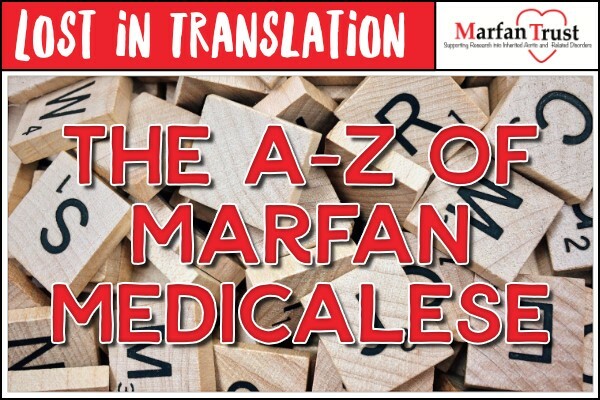Seeping into every aspect of your everyday existence, the feeling of fatigue becomes all-consuming and life-changing. It’s often experienced in Marfan syndrome, but can it be remedied, or alleviated by a change in medication or behaviour perhaps?
Fatigue is a problem that is often raised by members on our helpline. It is a symptom of Marfan syndrome and other connective tissue disorders that many people describe. However, the mechanisms are not clearly understood, and people can struggle to get the help and support they need. Symptoms of fatigue can affect all aspects of life, from managing to participate fully in school to limiting opportunities for employment.
What is Fatigue?
One of the first issues people experience when trying to discuss fatigue is that it can be very hard to explain and quantify their symptoms. It can feel non-specific and difficult to describe.
One definition is “an overwhelming sense of tiredness, lack of energy and feeling of exhaustion, mental, physical or both” (Maher et al, 2015)
Velvin et al (2023) interviewed people with Marfan syndrome in a focus group and they used words to describe fatigue that included:
Tiredness
Exhaustion
Lack of vitality
Foggy feeling
Parts of the body feeling heavy or paralyzed
Difficulty concentrating, speaking and listening
Possible Causes of Fatigue
Unfortunately, fatigue is a common feature of many chronic conditions, including connective tissue disorders like Marfan syndrome. It is felt in the muscles and joints. It is different from tiredness. Tiredness can be relieved by sleep and rest. Fatigue cannot, although sleep is obviously important.
Fatigue in Marfan syndrome can be a lifelong feature, due to the fact that fibrillin is an important component of muscles, tendons and ligaments. If this is deficient, then these structures are stretchier and weaker than normal. Gentle exercise can maintain strength, but building up muscle is very difficult,. In the literature, the prevalence of severe fatigue was reported as between 37-88.5% in various studies (Velvin et al, 2023), a huge range which demonstrates the difficulty in describing and quantifying fatigue. Often there is no obvious cause that can be found. However, there are some medical causes of fatigue that need to be considered by your clinicians, these include:
- Sleep apnoea (which is more common in MFS than in the general population)
- Insomnia
- Underactive thyroid gland
- Postural Orthostatic Tachycardia Syndrome (PoTS)
- Anaemia
- Depression
- Medication side effects
It’s important that you and your doctor think about whether any of these might be affecting you as treatment may be effective in relieving the symptoms.
There are features of a connective tissue disorder that may well contribute to fatigue, but further work is needed to explore causal relationships and look for other possible contributors to fatigue:
- Chronic pain
- Joint hypermobility
- Reduced physical activity
- Pharmacotherapy
- Living with uncertainty
How Does Fatigue Affect Life?
There are numerous studies exploring fatigue in MFS and they highlight the significant impact that it has on all aspects of life.
One study interviewed parents of children with MFS and described how the combination of pain, fatigue and skeletal issues caused negative effects on their child’s physical activity, psychosocial development, education and quality of life. Children with MFS can struggle to keep up with their peers, difficulty with simple tasks like walking, running, throwing and kicking a ball may mean they are left behind at playtime. Fatigue might mean that older children struggle to keep up with their friends if they have planned a busy day out and must make the decision to stay at home (Warninck et al, 2024).
Fatigue has an effect not just on the child, but on the whole family. Changes to family plans might need to be made, adaptations to holiday plans, days out or activities. This can be frustrating for siblings who might not understand and difficult for parents to manage. Some families find this increases the burden of day-to-day life, but many also report that overcoming these difficulties and finding solutions as a family can create a feeling of cohesiveness and caring.
Adults report similar impacts on their day-to-day life. One study looked at ‘satisfaction with life’ (SWL) in people with Marfan syndrome. Respondents reported that one of the main things that reduced their SWL was severe fatigue, (aortic dissection was reported as another important factor limiting SWL). Participants felt that fatigue often made them unable to carry out daily activities or desired activities, leading to a sense of frustration. Fatigue affects everything: health, family dynamics, work and employment, financial situation, relationships, autonomy, sense of purpose and personal growth (Velvin et al, 2016).
Some people described having to come to terms with fatigue as part of their illness, whilst debilitating and frustrating it is not dangerous but means difficult choices must be made about goals and priorities (Velvin et al, 2023).
Coping strategies
It’s important that individuals struggling with fatigue find strategies to try and cope with it while continuing to find satisfaction within their lives. Some of these suggestions might help with the symptoms of fatigue:
- Keep a Fatigue diary for a few weeks, you may begin to see trends or triggers for your fatigue that you can address
- Plan your time wisely and avoid ‘boom and bust’ behaviour e.g. trying to clean the whole house when you are feeling good only to suffer the consequences for the next 2 days
- Take regular exercise
- Eat a healthy, balanced diet
- Reduce your caffeine intake
- Stay well hydrated
- Improve the quality of your sleep (you may be sleeping too little or too much, you can look up advice for good sleep hygiene)
- Deal with anxiety or depression – speak to your GP or refer yourself to Talking Therapies (https://www.nhs.uk/mental-health/talking-therapies-medicine-treatments/talking-therapies-and-counselling/nhs-talking-therapies/)
- Plan and prioritise – think carefully about what you really want/need to do and factor these into your day or week before adding in other activities
- Work
o Talk to your employer if you are struggling as there may be options for flexible working, working from home or other adaptations that could help you
- School
o Talk to teachers and obtain support for children and young adults who may need adaptations or additional time or aids to reach their full potential at school
- Friends/Family
o Be honest with friends and family if you are struggling with fatigue, help them understand how you feel. Explain that you value them and their company but sometimes you can’t commit to activities
Physical Activity
Physical activity is a hot topic, frequently discussed by individuals with Marfan syndrome. Until recently, there had been a strong focus within healthcare settings on telling people with Marfan syndrome what they CANNOT do rather than what they CAN do. This can lead to people doing little or no physical activity as they deem it to be risky.
However, this needs to change, the physical and psychological benefits of exercise are well established, and these apply to people with Marfan syndrome as well as the general population. It’s vital that appropriate regular exercise is built into a daily routine and can help combat fatigue.
Instrumental in this is health care professionals offering tailored, specific advice about the types of activity people can safely do. This will obviously differ from person to person depending on how Marfan syndrome affects them. You can read more about physical activity guidelines HERE.
Along with this advice, there must be a greater focus on rehabilitation and physiotherapy to help people safely become more active. (Velvin et al, 2016). Rehab is available after events such as cardiac surgery.
There has been work done recently to look at the positive effect of physical activity upon the aorta. Research suggests that regular aerobic exercise can reduce the rate of change in the aortic root Z score and increase the elasticity of the aortic wall, which has great implications (Tierney et al, 2024). The study gave previously sedentary children with Marfan syndrome activity trackers and encouraged them to walk 10,000 steps per day. There were no detrimental effects from increasing physical activity.
Health Care Professionals
It’s important to note that many people with Marfan syndrome find it hard to discuss their fatigue with health care professionals. Rao et al (2016) found that fatigue was ranked as the 3rd highest health concern by people with MFS after aortic and spinal problems, however, it is rarely addressed in clinic appointments. Medical staff tend to focus on the more dangerous manifestations of the condition which means that fatigue may be ignored, despite its significant effect on a person’s quality of life. Clinicians need to ask about this aspect of Marfan syndrome and be proactive in helping patients find coping strategies or referring on to other services like Physiotherapy or Talking Therapies (Velvin et al, 2023).
References
Maher C, Crettenden A, Evans K, Thiessen M, Toohey M, Watson A, et al. Fatigue is a major issue for children and adolescents with physical disabilities. Dev Med Child Neurol. 2015;57(8):742–7. https://doi.org/10. 1111/dmcn.12736.
Rao, S.S., Venuti, K.D., Dietz 3rd, H.C. and Sponseller, P.D., 2016. Quantifying Health Status and Function in Marfan Syndrome. Journal of surgical orthopaedic advances, 25(1), pp.34-40.
Selamet Tierney, E.S., Chung, S., Stauffer, K.J., Brabender, J., Collins, R.T., Folk, R., Li, W., Murthy, A.K., Murphy, D.J. and Esfandiarei, M., 2022. Can 10 000 healthy steps a day slow aortic root dilation in pediatric patients with Marfan syndrome?. Journal of the American Heart Association, 11(23)
Velvin, G., Bathen, T., Rand-Hendriksen, S. and Geirdal, A.Ø., 2016. Satisfaction with life in adults with Marfan syndrome (MFS): associations with health-related consequences of MFS, pain, fatigue, and demographic factors. Quality of Life Research, 25, pp.1779-1790.
Velvin, G., Johansen, H., Østertun-Geirdal, A. and Bathen, T., 2023. Fatigue in patients with syndromic heritable thoracic aortic disease: a systematic review of the literature and a qualitative study of patients’ experiences and perceptions. Orphanet Journal of Rare Diseases, 18(1), p.119
Warnink-Kavelaars, J., de Koning, L.E., van der Hulst, A.E., Buizer, A.I., Poissonnier, N., Wijninga, L.E., Menke, L.A., Mosquera, L.M., Rombaut, L. and Engelbert, R.H., 2024. Physical fitness in children with Marfan and Loeys-Dietz syndrome: associations between cardiovascular parameters, systemic manifestations, fatigue, and pain. European journal of pediatrics, 183(5), pp.2421-2429.









